Water Resources Management Strategies for Irrigated Agriculture in the Indus Basin of Pakistan
Abstract
:1. Introduction
2. Materials and Methods
2.1. Study Area
2.2. The Spare:Water Model
2.3. Spatial Model Input Data
2.4. Parameterization
2.5. Scenario Evaluation
3. Results
3.1. Model Plausibility
3.2. Average Water Footprint of Crops
3.3. Regional Water Footprint for the Period 1997–2016
3.4. Sensitivity Analysis
3.5. Scenario Analysis
4. Discussion
4.1. Water Consumption and Policy Implication
4.2. Alternative Water Management Practices
5. Conclusions
Author Contributions
Funding
Acknowledgments
Conflicts of Interest
Appendix A
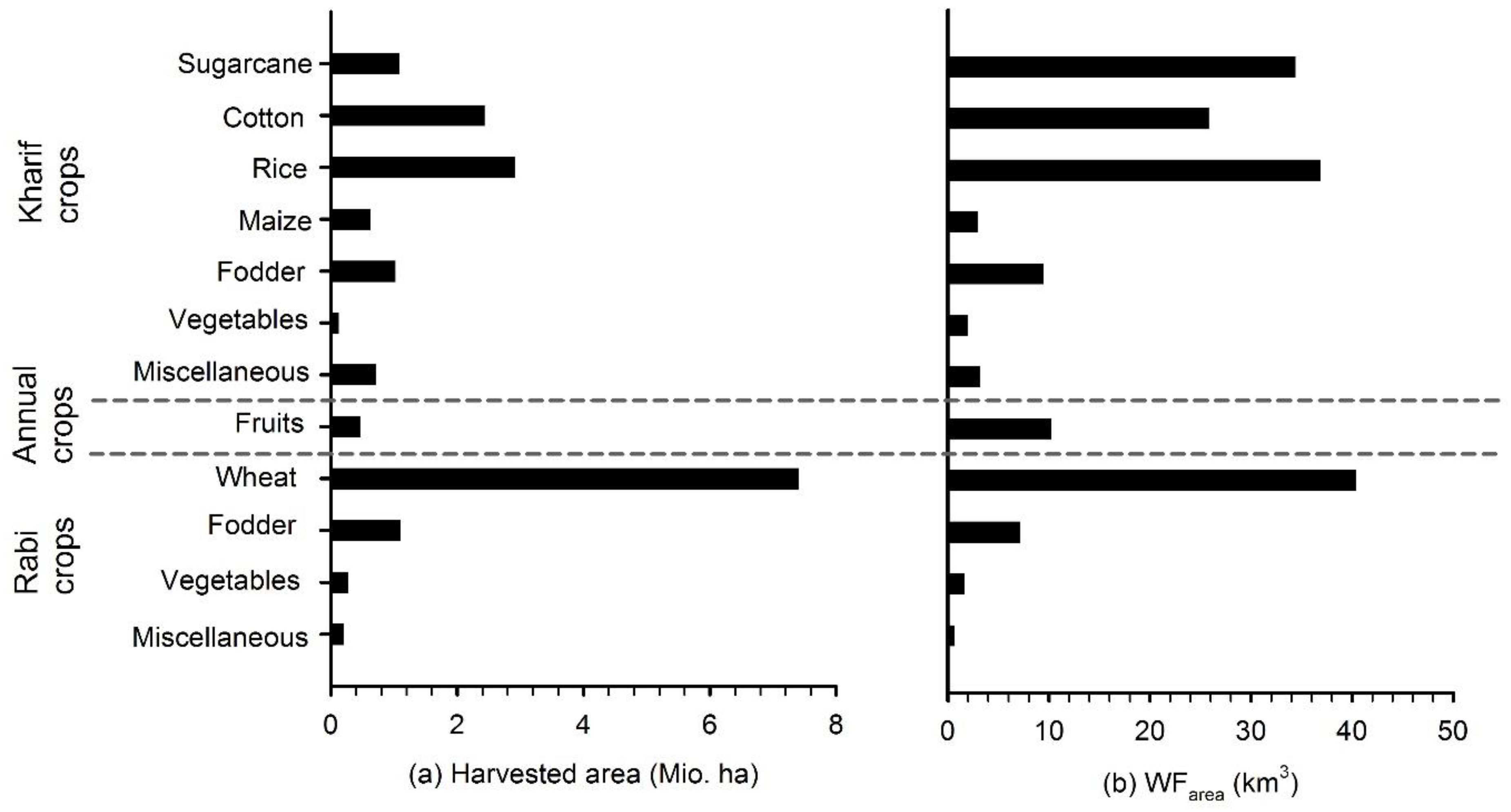
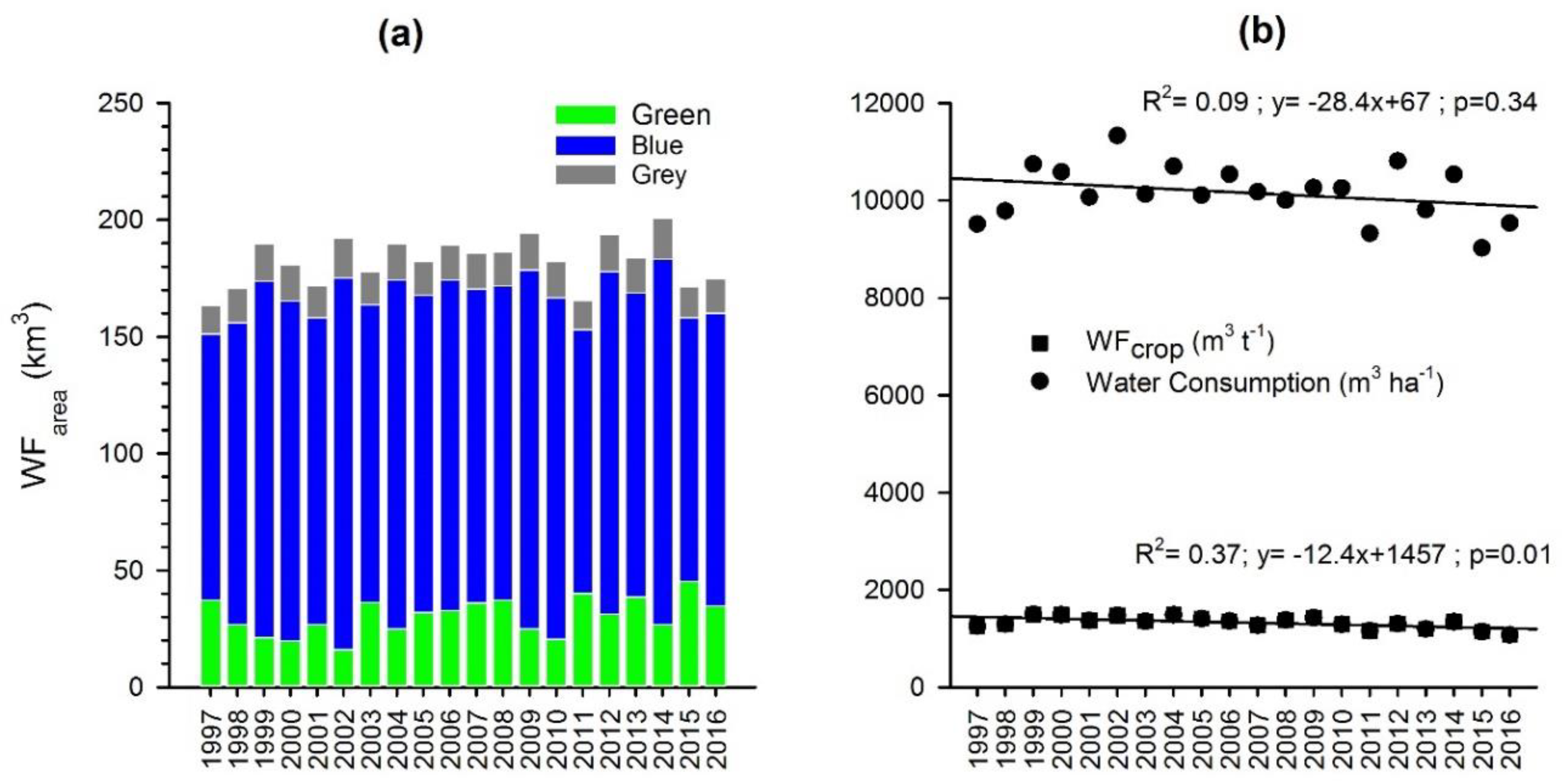
| Category | Crops | Crop Coefficients | Source | ||
|---|---|---|---|---|---|
| Kc in | Kc mid | Kc end | |||
| Cereal | Maize | 0.15 | 0.82 | 0.47 | Ullah et al. [40] |
| Rice | 0.28 | 1.26 | 0.44 | ||
| Sorghum | 0.23 | 0.92 | 0.52 | ||
| Wheat | 0.36 | 1.16 | 0.40 | ||
| Fiber | Cotton | 0.44 | 1.11 | 0.38 | |
| Sugar | Sugarcane | 0.52 | 1.17 | 0.88 | |
| Oilseed | Rapeseed | 0.25 | 0.97 | 0.32 | |
| Leguminous | Pulses | 0.37 | 0.95 | 0.34 | |
| Cereal | Barley | 0.30 | 1.15 | 0.25 | FAO Dataset [32] |
| Millet | 0.30 | 1.00 | 0.30 | ||
| Vegetables | Carrot | 0.70 | 1.05 | 0.95 | |
| Garlic | 0.70 | 1.00 | 0.70 | ||
| Gourd | 0.50 | 1.00 | 0.80 | ||
| Onion | 0.70 | 1.05 | 0.75 | ||
| Okra | 0.70 | 1.05 | 0.95 | ||
| Spinach | 0.70 | 1.00 | 0.95 | ||
| Tomato | 0.60 | 1.15 | 0.70 | ||
| Turnip | 0.50 | 1.10 | 0.95 | ||
| Spice | Pepper | 0.60 | 1.05 | 0.90 | |
| Tuber | Potato | 0.50 | 1.15 | 0.75 | |
| Oilseed | Sesame | 0.35 | 1.15 | 0.35 | |
| Fodder | Berseem | 0.40 | 0.90 | 0.85 | |
| Fruits | Banana | 1.00 | 1.20 | 1.10 | |
| Citrus | 0.75 | 0.70 | 0.75 | ||
| Dates | 0.90 | 0.95 | 0.95 | ||
| Mango | 0.60 | 0.80 | 0.60 | ||
| Guava | 0.80 | 1.00 | 0.80 | ||
| Harvested Area (Million Hectares yr−1) | |||||||||||||
|---|---|---|---|---|---|---|---|---|---|---|---|---|---|
| SET | Scenarios | Kharif Season Crops | Annual Crops | Rabi Season Crops | |||||||||
| Sugarcane | Cotton | Rice | Maize | Fodder | Vegetables | Miscellaneous | Fruits | Wheat | Fodder | Vegetables | Miscellaneous | ||
| Baseline | 1.09 | 2.43 | 2.92 | 0.62 | 1.02 | 0.12 | 0.71 | 0.46 | 7.41 | 1.10 | 0.27 | 0.20 | |
| SET1 | sc1 | 0 | 3.52 | 2.92 | 0.62 | 1.02 | 0.12 | 0.71 | 0.46 | 7.41 | 1.10 | 0.27 | 0.20 |
| sc2 | 0 | 2.43 | 4.01 | 0.62 | 1.02 | 0.12 | 0.71 | 0.46 | 7.41 | 1.10 | 0.27 | 0.20 | |
| sc3 | 0 | 2.43 | 2.92 | 1.71 | 1.02 | 0.12 | 0.71 | 0.46 | 7.41 | 1.10 | 0.27 | 0.20 | |
| sc4 | 0 | 2.43 | 2.92 | 0.62 | 2.12 | 0.12 | 0.71 | 0.46 | 7.41 | 1.10 | 0.27 | 0.20 | |
| sc5 | 0 | 2.43 | 2.92 | 0.62 | 1.02 | 1.22 | 0.71 | 0.46 | 7.41 | 1.10 | 0.27 | 0.20 | |
| sc6 | 0 | 2.43 | 2.92 | 0.62 | 1.02 | 0.12 | 0.71 | 1.55 | 7.41 | 1.10 | 0.27 | 0.20 | |
| SET2 | sc7 | 3.52 | 0 | 2.92 | 0.62 | 1.02 | 0.12 | 0.71 | 0.46 | 7.41 | 1.10 | 0.27 | 0.20 |
| sc8 | 1.09 | 0 | 5.34 | 0.62 | 1.02 | 0.12 | 0.71 | 0.46 | 7.41 | 1.10 | 0.27 | 0.20 | |
| sc9 | 1.09 | 0 | 2.92 | 3.04 | 1.02 | 0.12 | 0.71 | 0.46 | 7.41 | 1.10 | 0.27 | 0.20 | |
| sc10 | 1.09 | 0 | 2.92 | 0.62 | 3.45 | 0.12 | 0.71 | 0.46 | 7.41 | 1.10 | 0.27 | 0.20 | |
| sc11 | 1.09 | 0 | 2.92 | 0.62 | 1.02 | 2.55 | 0.71 | 0.46 | 7.41 | 1.10 | 0.27 | 0.20 | |
| sc12 | 1.09 | 0 | 2.92 | 0.62 | 1.02 | 0.12 | 0.71 | 2.88 | 7.41 | 1.10 | 0.27 | 0.20 | |
| SET3 | sc13 | 4.01 | 2.43 | 0 | 0.62 | 1.02 | 0.12 | 0.71 | 0.46 | 7.41 | 1.10 | 0.27 | 0.20 |
| sc14 | 1.09 | 5.34 | 0 | 0.62 | 1.02 | 0.12 | 0.71 | 0.46 | 7.41 | 1.10 | 0.27 | 0.20 | |
| sc15 | 1.09 | 2.43 | 0 | 3.53 | 1.02 | 0.12 | 0.71 | 0.46 | 7.41 | 1.10 | 0.27 | 0.20 | |
| sc16 | 1.09 | 2.43 | 0 | 0.62 | 3.94 | 0.12 | 0.71 | 0.46 | 7.41 | 1.10 | 0.27 | 0.20 | |
| sc17 | 1.09 | 2.43 | 0 | 0.62 | 1.02 | 3.04 | 0.71 | 0.46 | 7.41 | 1.10 | 0.27 | 0.20 | |
| sc18 | 1.09 | 2.43 | 0 | 0.62 | 1.02 | 0.12 | 0.71 | 3.37 | 7.41 | 1.10 | 0.27 | 0.20 | |
| SET4 | sc19 | 0 | 0 | 6.43 | 0.62 | 1.02 | 0.12 | 0.71 | 0.46 | 7.41 | 1.10 | 0.27 | 0.20 |
| sc20 | 0 | 0 | 2.92 | 4.13 | 1.02 | 0.12 | 0.71 | 0.46 | 7.41 | 1.10 | 0.27 | 0.20 | |
| sc21 | 0 | 0 | 2.92 | 0.62 | 4.54 | 0.12 | 0.71 | 0.46 | 7.41 | 1.10 | 0.27 | 0.20 | |
| sc22 | 0 | 0 | 2.92 | 0.62 | 1.02 | 3.64 | 0.71 | 0.46 | 7.41 | 1.10 | 0.27 | 0.20 | |
| sc23 | 0 | 0 | 2.92 | 0.62 | 1.02 | 0.12 | 0.71 | 3.98 | 7.41 | 1.10 | 0.27 | 0.20 | |
| SET5 | sc24 | 0 | 6.43 | 0 | 0.62 | 1.02 | 0.12 | 0.71 | 0.46 | 7.41 | 1.10 | 0.27 | 0.20 |
| sc25 | 0 | 2.43 | 0 | 4.63 | 1.02 | 0.12 | 0.71 | 0.46 | 7.41 | 1.10 | 0.27 | 0.20 | |
| sc26 | 0 | 2.43 | 0 | 0.62 | 5.03 | 0.12 | 0.71 | 0.46 | 7.41 | 1.10 | 0.27 | 0.20 | |
| sc27 | 0 | 2.43 | 0 | 0.62 | 1.02 | 4.13 | 0.71 | 0.46 | 7.41 | 1.10 | 0.27 | 0.20 | |
| sc28 | 0 | 2.43 | 0 | 0.62 | 1.02 | 0.12 | 0.71 | 4.47 | 7.41 | 1.10 | 0.27 | 0.20 | |
| SET6 | sc29 | 6.43 | 0 | 0 | 0.62 | 1.02 | 0.12 | 0.71 | 0.46 | 7.41 | 1.10 | 0.27 | 0.20 |
| sc30 | 1.09 | 0 | 0 | 5.96 | 1.02 | 0.12 | 0.71 | 0.46 | 7.41 | 1.10 | 0.27 | 0.20 | |
| sc31 | 1.09 | 0 | 0 | 0.62 | 6.37 | 0.12 | 0.71 | 0.46 | 7.41 | 1.10 | 0.27 | 0.20 | |
| sc32 | 1.09 | 0 | 0 | 0.62 | 1.02 | 5.47 | 0.71 | 0.46 | 7.41 | 1.10 | 0.27 | 0.20 | |
| sc33 | 1.09 | 0 | 0 | 0.62 | 1.02 | 0.12 | 0.71 | 5.80 | 7.41 | 1.10 | 0.27 | 0.20 | |
| SET7 | sc34 | 0 | 0 | 0 | 7.05 | 1.02 | 0.12 | 0.71 | 0.46 | 7.41 | 1.10 | 0.27 | 0.20 |
| sc35 | 0 | 0 | 0 | 0.62 | 7.46 | 0.12 | 0.71 | 0.46 | 7.41 | 1.10 | 0.27 | 0.20 | |
| sc36 | 0 | 0 | 0 | 0.62 | 1.02 | 6.56 | 0.71 | 0.46 | 7.41 | 1.10 | 0.27 | 0.20 | |
| sc37 | 0 | 0 | 0 | 0.62 | 1.02 | 0.12 | 0.71 | 6.89 | 7.41 | 1.10 | 0.27 | 0.20 | |
References
- Yang, Y.C. Ethan; Ringler Claudia; Brown Casey; Mondal Md. Alam Hossain Modeling the Agricultural Water–Energy–Food Nexus in the Indus River Basin, Pakistan. J. Water Resour. Plann. Manag. 2016, 142, 04016062. [Google Scholar] [CrossRef]
- Ringler, C.; Anwar, A. Water for food security: Challenges for Pakistan. Water Int. 2013, 38, 505–514. [Google Scholar] [CrossRef]
- Bandaragoda, D.J.; Rehman, S. ur. Warabandi in Pakistan’s Canal Irrigation Systems: Widening Gap between Theory and Practice; IWMI Books, Reports; International Water Management Institute: Colombo, Sri Lanka, 1995. [Google Scholar]
- Mekonnen, D.K.; Channa, H.; Ringler, C. The impact of water users’ associations on the productivity of irrigated agriculture in Pakistani Punjab. Water Int. 2015, 40, 733–747. [Google Scholar] [CrossRef] [Green Version]
- Ahmad, S. Land and Water Resources of Pakistan—A Critical Assessment. Pak. Dev. Rev. 2007, 46, 911–937. [Google Scholar] [CrossRef] [Green Version]
- Qureshi, A.S.; McCornick, P.G.; Sarwar, A.; Sharma, B.R. Challenges and Prospects of Sustainable Groundwater Management in the Indus Basin, Pakistan. Water Resour. Manag. 2010, 24, 1551–1569. [Google Scholar] [CrossRef] [Green Version]
- Cheema, M.J.M.; Immerzeel, W.W.; Bastiaanssen, W.G.M. Spatial Quantification of Groundwater Abstraction in the Irrigated Indus Basin. Groundwater 2014, 52, 25–36. [Google Scholar] [CrossRef] [PubMed] [Green Version]
- Sarwar, A.; Eggers, H. Development of a conjunctive use model to evaluate alternative management options for surface and groundwater resources. Hydrogeol. J. 2006, 14, 1676–1687. [Google Scholar] [CrossRef]
- Qureshi, A.S.; McCornick, P.G.; Qadir, M.; Aslam, Z. Managing salinity and waterlogging in the Indus Basin of Pakistan. Agric. Water Manag. 2008, 95, 1–10. [Google Scholar] [CrossRef]
- World Bank. Pakistan—Punjab Private Sector Groundwater Development Project (English); World Bank: Washington, DC, USA, 2002. [Google Scholar]
- Qureshi, A.S. Water Management in the Indus Basin in Pakistan: Challenges and Opportunities. MRED 2011, 31, 252–260. [Google Scholar] [CrossRef]
- Bhutta, N.; Smedema, K. One hundred years of waterlogging and salinity control in the Indus valley, Pakistan: A historical review. Irrig. Drain. 2007, 56, S81–S90. [Google Scholar] [CrossRef]
- Falkenmark, M. The Massive Water Scarcity Now Threatening Africa: Why Isn’t It Being Addressed? Ambio 1989, 18, 112–118. [Google Scholar]
- Briscoe, J.; Qamar, U. Pakistan’s Water Economy: Running Dry; The World Bank: Washington, DC, USA, 2005; pp. 1–155. [Google Scholar]
- Kirby, M.; Ahmad, M.-D.; Mainuddin, M.; Khaliq, T.; Cheema, M.J.M. Agricultural production, water use and food availability in Pakistan: Historical trends, and projections to 2050. Agric. Water Manag. 2017, C, 34–46. [Google Scholar] [CrossRef]
- Ministry of Water Resources. Pakistan-National Water Policy; Government of Pakistan: Islamabad, Pakistan, 2018. Available online: https://ffc.gov.pk/wp-content/uploads/2018/12/National-Water-Policy-April-2018-FINAL_3.pdf (accessed on 22 January 2020).
- Galindo, A.; Collado-González, J.; Griñán, I.; Corell, M.; Centeno, A.; Martín-Palomo, M.J.; Girón, I.F.; Rodríguez, P.; Cruz, Z.N.; Memmi, H.; et al. Deficit irrigation and emerging fruit crops as a strategy to save water in Mediterranean semiarid agrosystems. Agric. Water Manag. 2018, 202, 311–324. [Google Scholar] [CrossRef]
- Evans, R.G.; Sadler, E.J. Methods and technologies to improve efficiency of water use. Water Resour. Res. 2008, 44. [Google Scholar] [CrossRef]
- Hu, H.; Xiong, L. Genetic engineering and breeding of drought-resistant crops. Ann. Rev. Plant Biol. 2014, 65, 715–741. [Google Scholar] [CrossRef]
- Davis, K.F.; Seveso, A.; Rulli, M.C.; D’Odorico, P. Water Savings of Crop Redistribution in the United States. Water 2017, 9, 83. [Google Scholar] [CrossRef] [Green Version]
- Kader, M.A.; Singha, A.; Begum, M.A.; Jewel, A.; Khan, F.H.; Khan, N.I. Mulching as water-saving technique in dryland agriculture: Review article. Bull. Natl. Res. Cent. 2019, 43, 147. [Google Scholar] [CrossRef] [Green Version]
- Ali, A.B.; Elshaikh, N.A.; Hong, L.; Adam, A.B.; Haofang, Y. Conservation tillage as an approach to enhance crops water use efficiency. Acta Agric. Scand. Sect. B Soil Plant Sci. 2017, 67, 252–262. [Google Scholar] [CrossRef]
- Hoekstra, A.Y.; Chapagain, A.; Martinez-Aldaya, M.; Mekonnen, M. The Water Footprint Assessment Manual, Setting the Global Standard; Earthscan: London, UK, 2011; ISBN 978-1-84971-279-8. [Google Scholar]
- Mali, S.S.; Singh, D.K.; Sarangi, A.; Parihar, S.S. Crop water footprints with special focus on response formulation: The case of Gomti river basin (India). Environ. Earth Sci. 2017, 76, 786. [Google Scholar] [CrossRef]
- García Morillo, J.; Rodríguez Díaz, J.A.; Camacho, E.; Montesinos, P. Linking water footprint accounting with irrigation management in high value crops. J. Clean. Prod. 2015, 87, 594–602. [Google Scholar] [CrossRef]
- Lathuillière, M.J.; Cao, M.T.; Castanho, A.; Graesser, J.; Johnson, M. K Evaluating Water Use for Agricultural Intensification in Southern Amazonia Using the Water Footprint Sustainability Assessment. Water 2018, 10, 349. [Google Scholar] [CrossRef] [Green Version]
- Nouri, H.; Stokvis, B.; Galindo, A.; Blatchford, M.; Hoekstra, A.Y. Water scarcity alleviation through water footprint reduction in agriculture: The effect of soil mulching and drip irrigation. Sci. Environ. 2019, 653, 241–252. [Google Scholar] [CrossRef] [PubMed]
- Cao, X.; Wu, P.; Wang, Y.; Zhao, X. Water Footprint of Grain Product in Irrigated Farmland of China. Water Resour. Manag. 2014, 28, 2213–2227. [Google Scholar] [CrossRef]
- Multsch, S.; Alquwaizany, A.S.; Alharbi, O.A.; Pahlow, M.; Frede, H.-G.; Breuer, L. Water-saving strategies for irrigation agriculture in Saudi Arabia. Int. J. Water Resour. Dev. 2017, 33, 292–309. [Google Scholar] [CrossRef]
- Tsakmakis, I.D.; Zoidou, M.; Gikas, G.D.; Sylaios, G.K. Impact of Irrigation Technologies and Strategies on Cotton Water Footprint Using AquaCrop and CROPWAT Models. Environ. Process. 2018, 5, 181–199. [Google Scholar] [CrossRef]
- Multsch, S.; Al-Rumaikhani, Y.A.; Frede, H.-G.; Breuer, L. A Site-sPecific Agricultural water Requirement and footprint Estimator (SPARE:WATER 1.0). Geosci. Model Dev. 2013, 6, 1043–1059. [Google Scholar] [CrossRef]
- Allen, R.G.; Pereira, L.S.; Raes, D.; Smith, M. Crop Evapotranspiration—Guidelines for Computing Crop Water Requirements—FAO Irrigation and Drainage Paper 56; FAO: Rome, Italy, 1998. [Google Scholar]
- Multsch, S.; Pahlow, M.; Ellensohn, J.; Michalik, T.; Frede, H.-G.; Breuer, L. A hotspot analysis of water footprints and groundwater decline in the High Plains aquifer region, USA. Reg. Environ. Chang. 2016, 16, 2419–2428. [Google Scholar] [CrossRef]
- Multsch, S.; Elshamy, M.E.; Batarseh, S.; Seid, A.H.; Frede, H.-G.; Breuer, L. Improving irrigation efficiency will be insufficient to meet future water demand in the Nile Basin. J. Hydrol. Reg. Stud. 2017, 12, 315–330. [Google Scholar] [CrossRef]
- Multsch, S.; Krol, M.S.; Pahlow, M.; Assunção, A.L.C.; Barretto, A.G.O.P.; de Jong van Lier, Q.; Breuer, L. Assessment of potential implications of agricultural irrigation policy on surface water scarcity in Brazil. Hydrol. Earth Syst. Sci. 2020, 24, 307–324. [Google Scholar] [CrossRef] [Green Version]
- Multsch, S.; Grabowski, D.; Luedering, J.; Alquwaizany, A.S.; Lehnert, K.; Frede, H.-G.; Winker, P.; Breuer, L. A practical planning software program for desalination in agriculture-SPARE: WATER(opt). Desalination 2017, 404, 121–131. [Google Scholar] [CrossRef]
- Multsch, S.; Exbrayat, J.-F.; Kirby, M.; Viney, N.R.; Frede, H.-G.; Breuer, L. Reduction of predictive uncertainty in estimating irrigation water requirement through multi-model ensembles and ensemble averaging. Geosci. Model Dev. 2015, 8, 1233–1244. [Google Scholar] [CrossRef] [Green Version]
- Brouwer, C.; Prins, K.; Heibloem, M. Irrigation Water Management: Training Manual No. 4: Irrigation Scheduling; FAO: Rome, Italy, 1989. [Google Scholar]
- International Water Management Institute (IWMI). IWMI Irrigated Area Mapping: Asia and Africa: IWMI Data & Tools. 2018. Available online: http://www.iwmi.cgiar.org/2018/06/irrigated-area-mapping-asia-and-africa/ (accessed on 20 October 2019).
- Ullah, M.K.; Habib, Z.; Muhammad, S. Spatial Distribution of Reference and Potential Evapotranspiration across the Indus Basin Irrigation Systems; IWMI: Lahore, Pakistan, 2001; ISBN 978-92-9090-206-5. [Google Scholar]
- Ayers, R.S.; Westcot, D.W. Water Quality for Agriculture; FAO irrigation and drainage paper; Food and Agriculture Organization of the United Nations: Rome, Italy, 1985; ISBN 978-92-5-102263-4. [Google Scholar]
- Shakir, A.S.; Khan, N.M.; Qureshi, M.M. Canal water management: Case study of upper Chenab Canal in Pakistan. Irrig. Drain. 2010, 59, 76–91. [Google Scholar] [CrossRef]
- Soomro, Z.A.; Ashraf, M.; Ejaz, K.; Bhatti, A.Z. Water Requirements of Major Crops in the Central Punjab; PCRWR: Islamabad, Pakistan, 2018; p. 44.
- Ghufran, M.A.; Butt, M.A.; Farooqi, A.; Batool, A.; Irfan, M.F. Water Footprint of Major Cereals and Some Selected Minor Crops of Pakistan. J. Water Resour. Hydraul. Eng. 2015, 59, 76–91. [Google Scholar] [CrossRef]
- World Program for the Census of Agriculture 2020. Volume 1. Available online: https://unstats.un.org/unsd/classifications/Family/Detail/1002 (accessed on 9 March 2020).
- Rehman, A.; Jingdong, L.; Chandio, A.; Shabbir, M.; Hussain, I. Economic outlook of rice crops in Pakistan: A time series analysis (1970–2015). Finan. Innov. 2017, 13, 1–9. [Google Scholar] [CrossRef] [Green Version]
- Hess, T.; Knox, J.; Kay, M.; Weatherhead, K. Managing the Water Footprint of Irrigated Food Production in England and Wales. In Sustainable Water; Royal Society of Chemistry: Birmingham, UK, 2010; pp. 78–92. [Google Scholar] [CrossRef]
- Montesinos, P.; Camacho, E.; Campos, B.; Rodríguez-Díaz, J.A. Analysis of Virtual Irrigation Water. Application to Water Resources Management in a Mediterranean River Basin. Water Resour. Manag. 2011, 25, 1635–1651. [Google Scholar] [CrossRef]
- Chukalla, A.D.; Krol, M.S.; Hoekstra, A.Y. Green and blue water footprint reduction in irrigated agriculture: Effect of irrigation techniques, irrigation strategies and mulching. Hydrol. Earth Syst. Sci. 2015, 19, 4877–4891. [Google Scholar] [CrossRef] [Green Version]
- Aldaya, M.M.; Garrido, A.; Llamas, M.R.; Varela-Ortega, C.; Novo, P.; Casado, R.R. Water Footprint and Virtual Water Trade in Spain. 11. Available online: https://waterfootprint.org/media/downloads/Aldaya-el-al-2010-WaterFootprintSpain_1.pdf (accessed on 4 March 2020).
- Chapagain, A.K.; Tickner, D. Water Footprint: Help or Hindrance? Water Alter. 2012, 5, 563–581. [Google Scholar]
- Liu, J.; Orr, S. Water footprint overview in the governmental, public policy, and corporate contexts. In Proceedings of the “On the Water Front”: Selections from the 2009 World Water Week in Stockholm; Stockholm International Water Institute (SIWI), Stockholm, Sweden, 16 August 2009; pp. 73–79. [Google Scholar]
- Dong, H.; Geng, Y.; Sarkis, J.; Fujita, T.; Okadera, T.; Xue, B. Regional water footprint evaluation in China: A case of Liaoning. Sci. Environ. 2013, 442, 215–224. [Google Scholar] [CrossRef]
- Chapagain, A.K.; Hoekstra, A.Y.; Savenije, H.H.G. Water saving through international trade of agricultural products. Hydrol. Earth Syst. Sci. 2006, 10, 455–468. [Google Scholar] [CrossRef] [Green Version]
- Dumont, A.; Salmoral, G.; Llamas, M.R. The water footprint of a river basin with a special focus on groundwater: The case of Guadalquivir basin (Spain). Water Resour. Ind. 2013, 1–2, 60–76. [Google Scholar] [CrossRef] [Green Version]
- Aldaya, M.M.; Martínez-Santos, P.; Llamas, M.R. Incorporating the Water Footprint and Virtual Water into Policy: Reflections from the Mancha Occidental Region, Spain. Water Resour. Manag. 2010, 24, 941–958. [Google Scholar] [CrossRef] [Green Version]
- Water Development for Irrigated Agriculture in Pakistan: Past Trends, Returns and Future Requirements—Hafeez Akhtar Randhawa. Available online: http://www.fao.org/3/ac623e/ac623e0i.htm (accessed on 28 January 2019).
- Ghasemi, M.M.; Karamouz, M.; Shui, L.T. Distributed versus Lumped Optimization of Cropping Pattern and Water Resources Utilization. AS 2014, 5, 257–269. [Google Scholar] [CrossRef] [Green Version]
- Zeng, Z.; Liu, J.; Koeneman, P.H.; Zarate, E.; Hoekstra, A.Y. Assessing water footprint at river basin level: A case study for the Heihe River Basin in northwest China. Hydrol. Earth Syst. Sci. 2012, 16, 2771–2781. [Google Scholar] [CrossRef] [Green Version]
- Maisiri, N.; Senzanje, A.; Rockstrom, J.; Twomlow, S.J. On farm evaluation of the effect of low cost drip irrigation on water and crop productivity compared to conventional surface irrigation system. Phys. Chem. Earth Parts A/B/C 2005, 30, 783–791. [Google Scholar] [CrossRef]
- Liu, H.-J.; Kang, Y.; Yao, S.-M.; Sun, Z.-Q.; Liu, S.-P.; Wang, Q.-G. Field Evaluation on Water Productivity of Winter Wheat under Sprinkler or Surface Irrigation in the North China Plain. Irrig. Drain. 2013, 62, 37–49. [Google Scholar] [CrossRef]
- Rizwan, M.; Bakhsh, A.; Li, X.; Anjum, L.; Jamal, K.; Hamid, S. Evaluation of the Impact of Water Management Technologies on Water Savings in the Lower Chenab Canal Command Area, Indus River Basin. Water 2018, 10, 681. [Google Scholar] [CrossRef] [Green Version]
- Latif, M. Sprinkler irrigation to harness potential benefits of water scarcity areas in Pakistan. In Proceedings of the National Seminar on Water Resources Development and Management in Arid Areas, Quetta, Pakistan, 11–12 August 1990. [Google Scholar]
- Yasin, M.; Ahmad, S.; Aslam, M.; Akbar, G. Adaption of pressurized irrigation in Pakistan. In Proceedings of the International Seminar on “Management of Water Resources for Sustainable Agriculture”, Lahore, Pakistan, 29–31 October 2001. [Google Scholar]
- Alam, M.M.; Bhutta, M.N.; Azhar, A.H. Use and Limitations of Sprinkler and Drip Irrigation Systems in Pakistan. In Proceedings of the Pakistan Engineering Congress, 70th Annual session, Lahore, Pakistan, 2–4 December 2006. [Google Scholar]
- Rodrigues, G.C.; Martins, J.D.; Petry, M.T.; Carlesso, R.; Paredes, P.; Rosa, R.D.; Pereira, L.S. Economic impacts assessment of deficit irrigation and commodity prices. Application to maize in southern Brazil. In Proceedings of the International Conference on Agricultural Engineering, Valencia, Spain, 8–12 July 2012; pp. 8–12. [Google Scholar]
- PMU, PIPIP, PUNJAB. Available online: http://www.pipip.punjab.gov.pk/ (accessed on 3 December 2019).
- Qamar, M.U.; Azmat, M.; Abbas, A.; Usman, M.; Shahid, M.A.; Khan, Z.M. Water Pricing and Implementation Strategies for the Sustainability of an Irrigation System: A Case Study within the Command Area of the Rakh Branch Canal. Water 2018, 10, 509. [Google Scholar] [CrossRef] [Green Version]
- Kahlown, M.A.; Raoof, A.; Zubair, M.; Kemper, W.D. Water use efficiency and economic feasibility of growing rice and wheat with sprinkler irrigation in the Indus Basin of Pakistan. Agric. Water Manag. 2007, 87, 292–298. [Google Scholar] [CrossRef]
- Abdulai, A.; Owusu, V.; Bakang, J.-E.A. Adoption of safer irrigation technologies and cropping patterns: Evidence from Southern Ghana. Ecol. Econ. 2011, 70, 1415–1423. [Google Scholar] [CrossRef] [Green Version]
- Rehman, A.; Jingdong, L.; Shahzad, B.; Chandio, A.A.; Hussain, I.; Nabi, G.; Iqbal, M.S. Economic perspectives of major field crops of Pakistan: An empirical study. Pac. Sci. Rev. B Hum. Soc. Sci. 2015, 1, 145–158. [Google Scholar] [CrossRef] [Green Version]
- Mojtabavi, S.A.; Shokoohi, A.; Etedali, H.R.; Singh, V. Using Regional Virtual Water Trade and Water Footprint Accounting for Optimizing Crop Patterns to Mitigate Water Crises in Dry Regions. Irrig. Drain. 2018, 67, 295–305. [Google Scholar] [CrossRef]
- Rasul, G.; Mahmood, A.; Sadiq, A.; Khan, S.I. Vulnerability of the Indus Delta to Climate Change in Pakistan. Pak. J. Met. 2012, 8, 89–107. [Google Scholar]
- Awan, U.K.; Liaqat, U.W.; Choi, M.; Ismaeel, A. A SWAT modeling approach to assess the impact of climate change on consumptive water use in Lower Chenab Canal area of Indus basin. Hydrol. Res. 2016, 47, 1025–1037. [Google Scholar] [CrossRef]
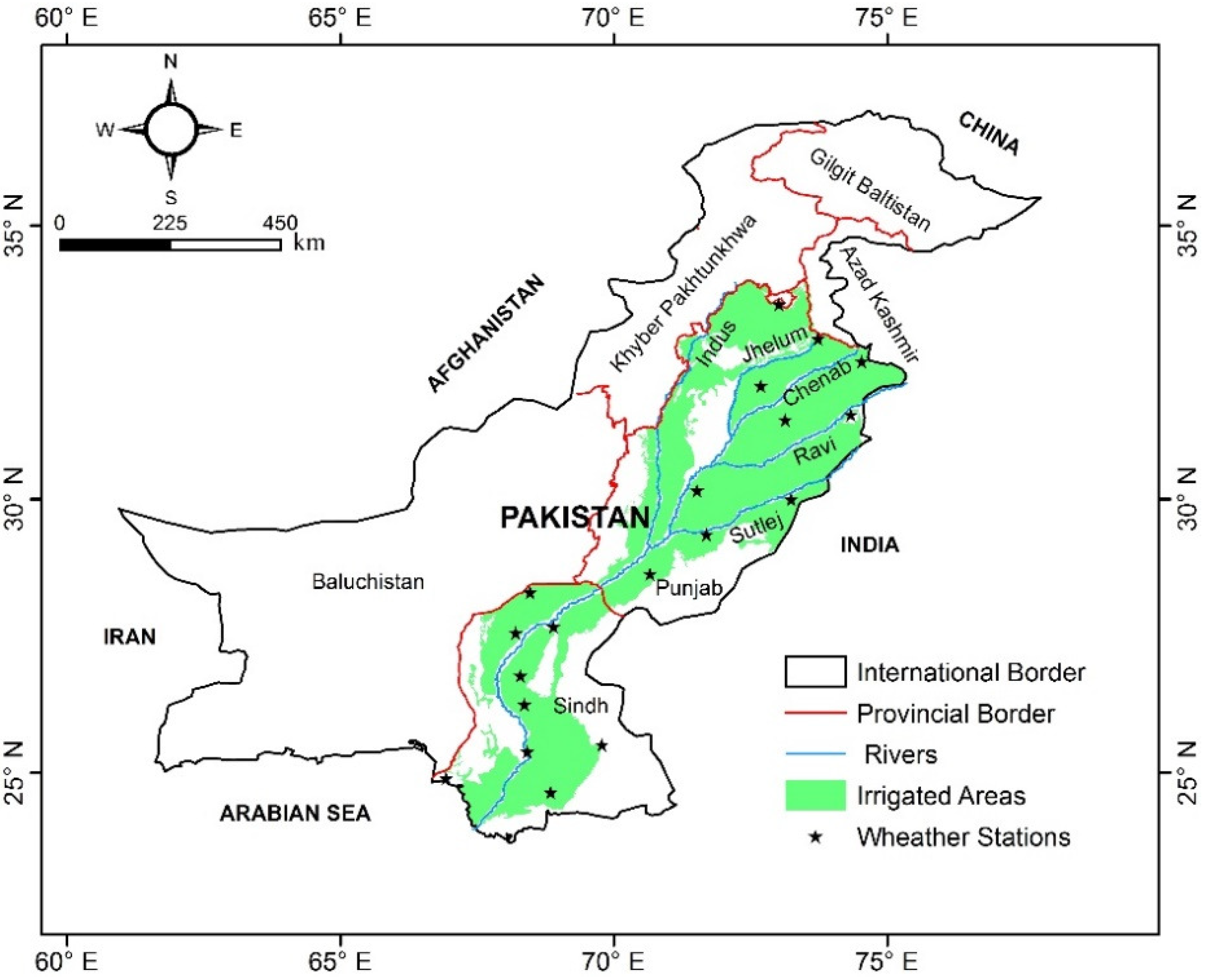
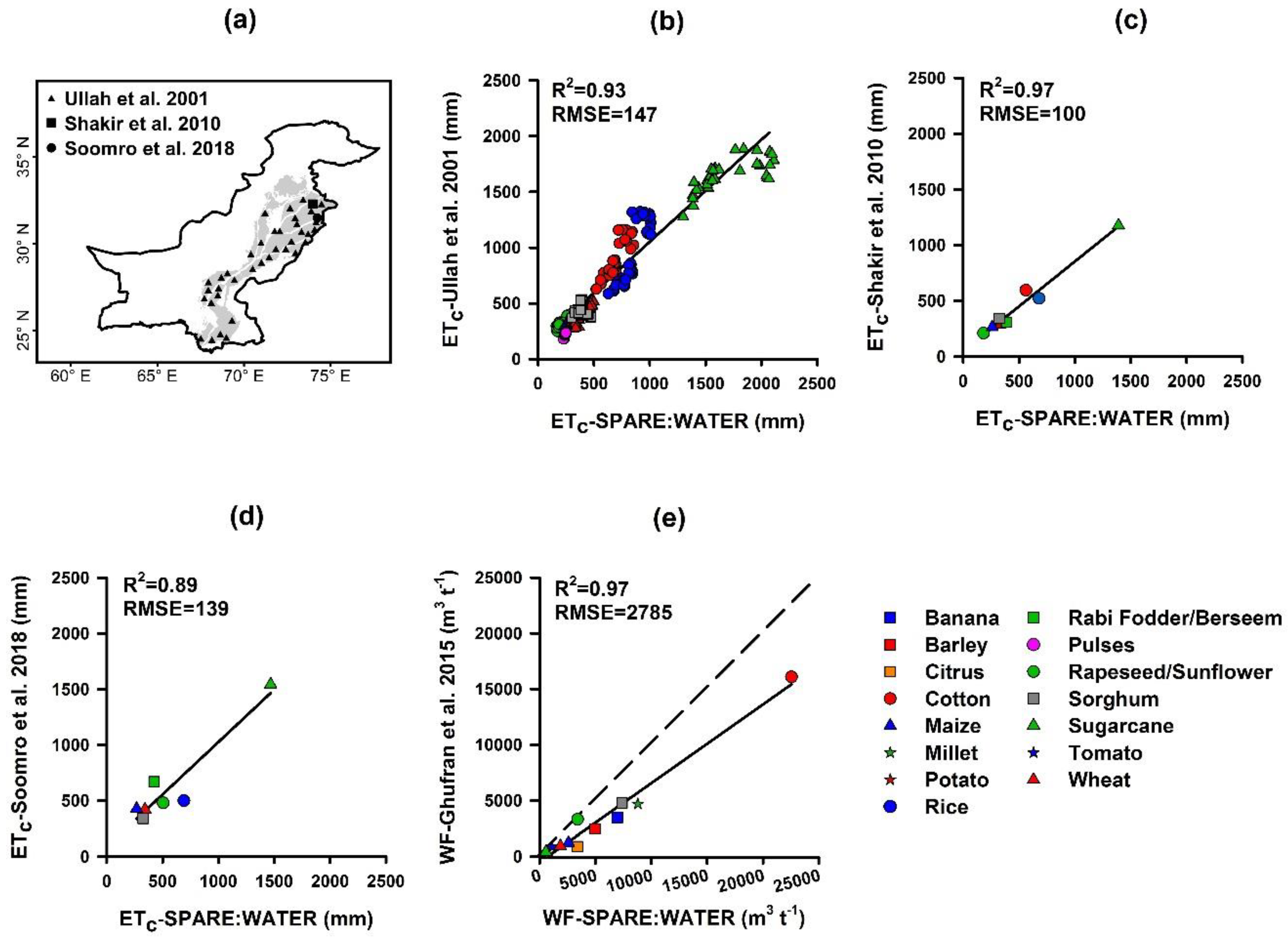
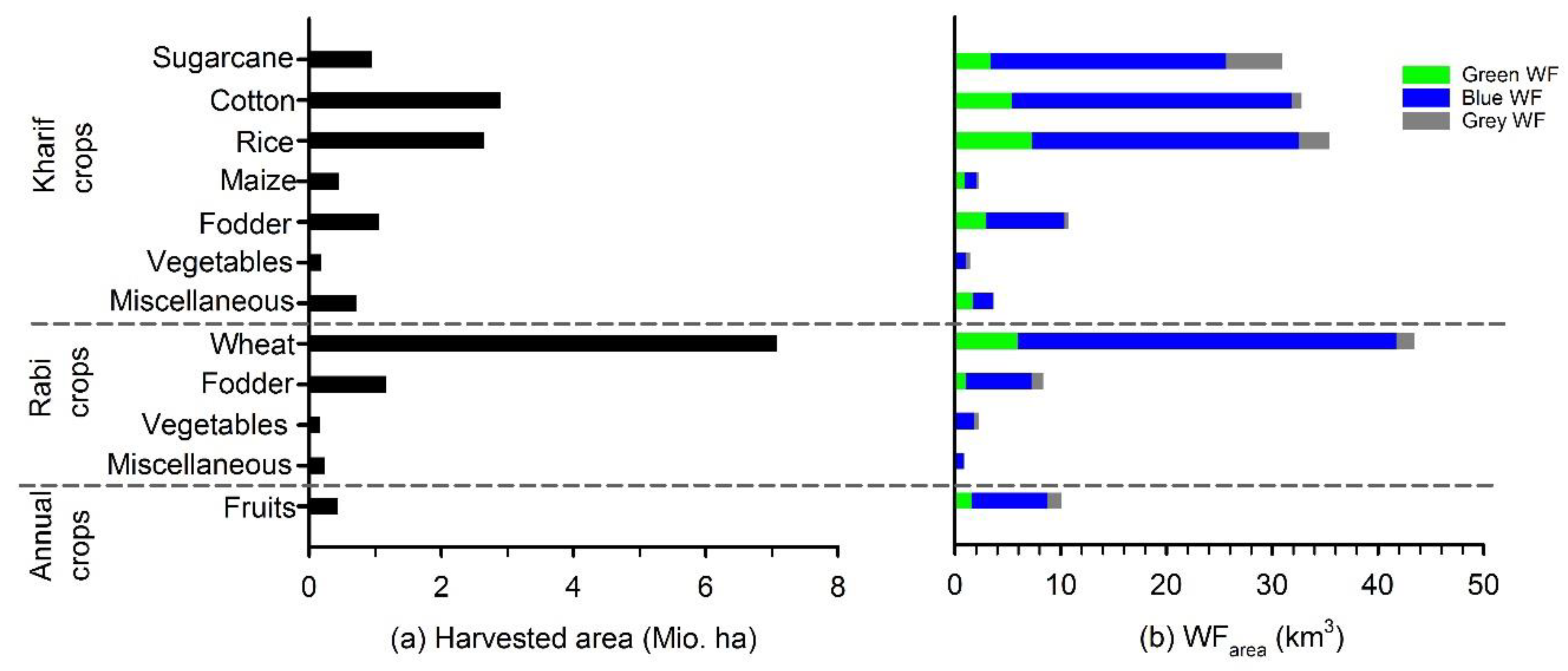
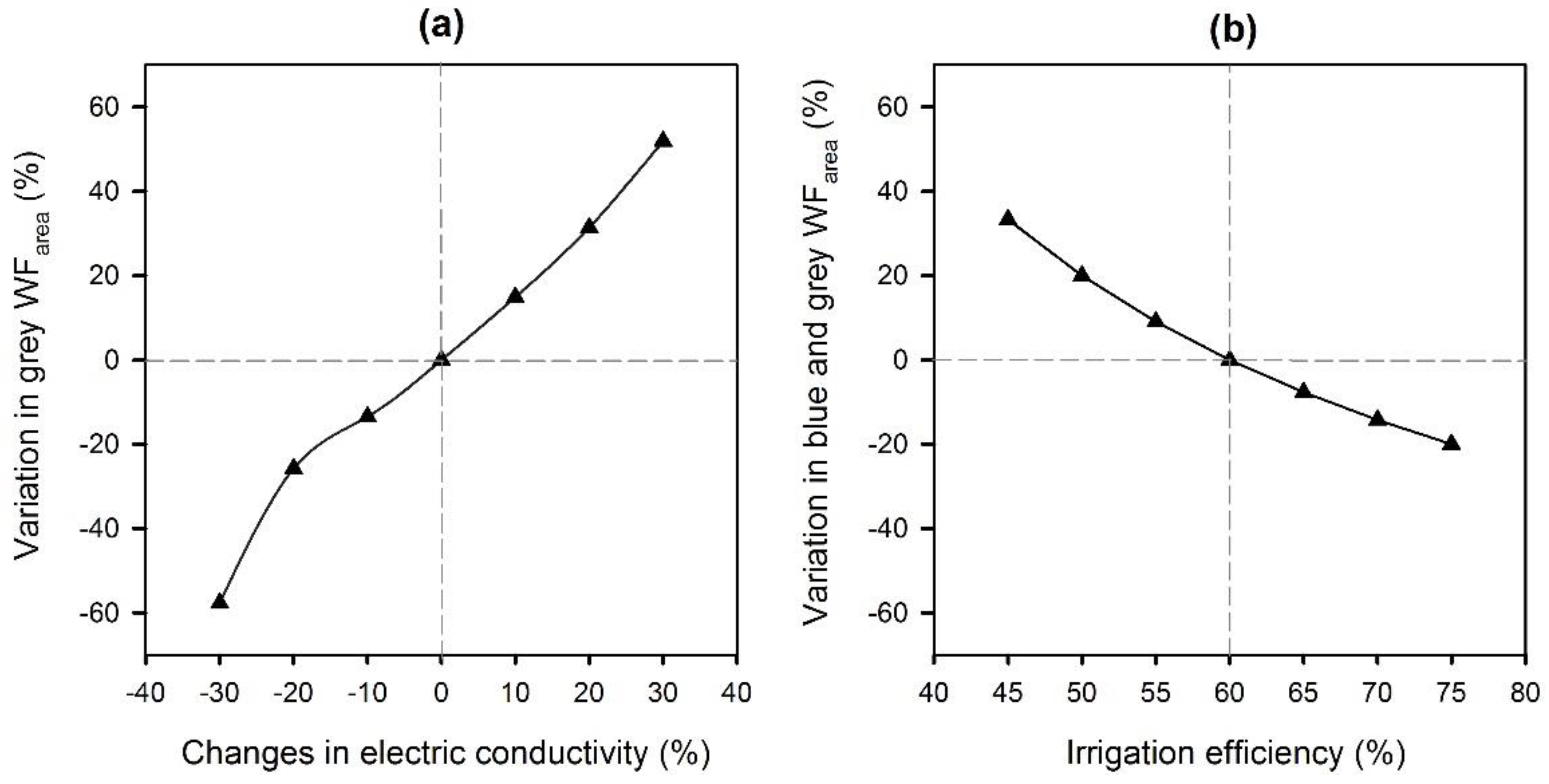
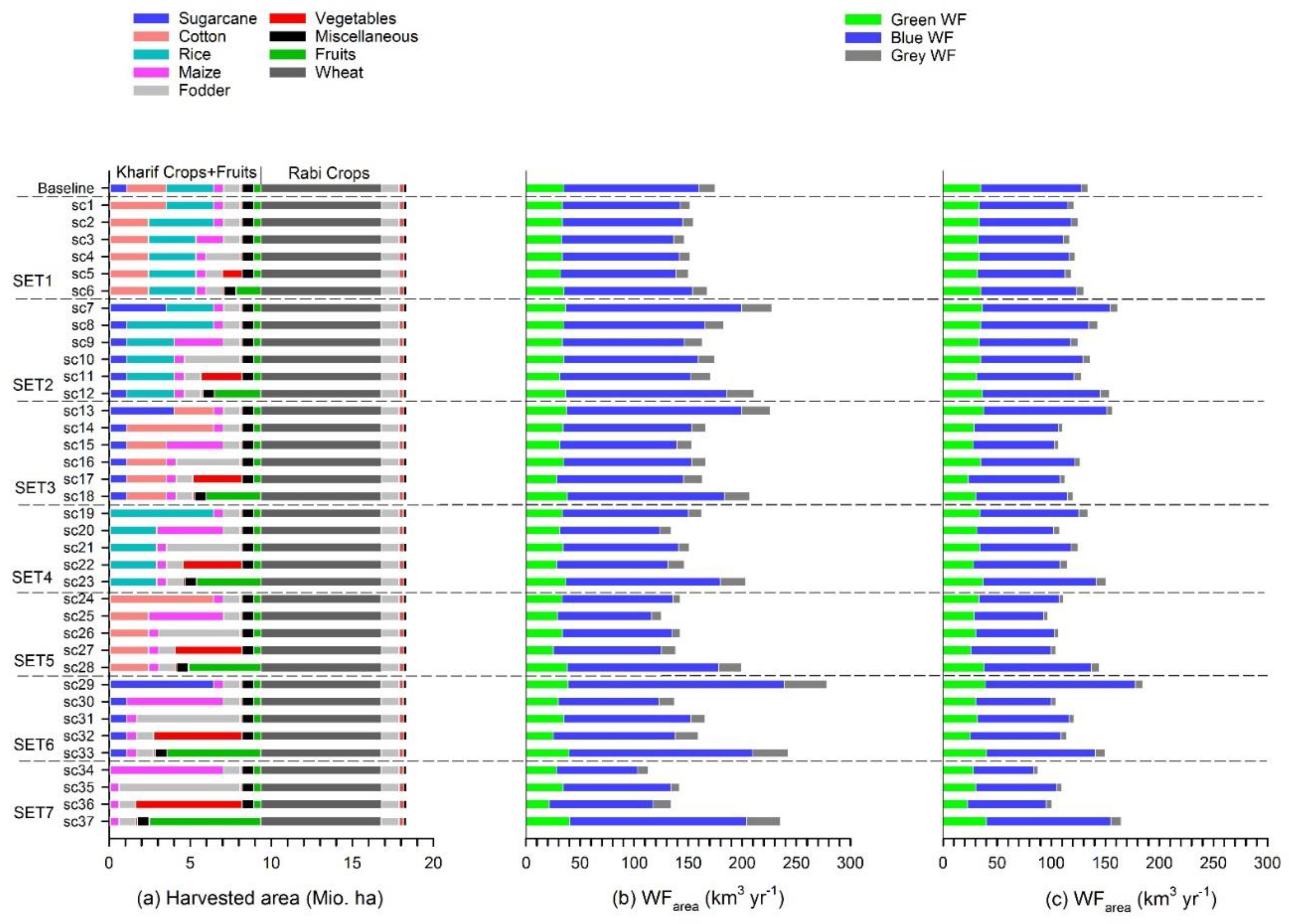
| Dataset | Description | Years/Resolution | Data Sources |
|---|---|---|---|
| Climate | Rainfall, wind speed, min. and max. temperature, relative humidity, sunshine hours for 19 weather stations | 1997–2016 Monthly | Pakistan Meteorological Department |
| Irrigated areas | Spatial location of areas | 2010 | International Water Management Institute (IWMI) [39] |
| Crop data | Harvested area and crop production | 1997–2016 Yearly | Pakistan Statistics Bureau Islamabad |
| Crop parameters | Sowing and harvesting date | - | National Agromet Centre of Pakistan |
| Groundwater quality | Electric conductivity dataset of 3500 wells | 2010–2014 | International Water-Logging and Salinity Research Institute (IWASRI) |
| Season | Category | Crops | Yield (t ha−1) | WF (m3 t−1) | |||
|---|---|---|---|---|---|---|---|
| Green | Blue | Grey | Total | ||||
| Kharif | Cereal | Rice | 2.1 | 1488 | 4971 | 542 | 7001 |
| Maize | 2.6 | 839 | 1706 | 424 | 2969 | ||
| Sorghum | 0.7 | 2981 | 5763 | 253 | 8997 | ||
| Millet | 0.6 | 3390 | 6558 | 292 | 10,240 | ||
| Fiber | Cotton | 0.53 | 6886 | 13,315 | 489 | 20,690 | |
| Sugar | Sugarcane | 50 | 76 | 469 | 110 | 655 | |
| Oilseed | Sesame | 0.5 | 4809 | 12,086 | 528 | 17,423 | |
| Fodder | Sorghum(Jowar) | 12.5 | 229 | 616 | 30 | 875 | |
| Vegetables | Okra | 8.3 | 109 | 1387 | 270 | 1766 | |
| Gourd | 8.7 | 104 | 1186 | 225 | 1515 | ||
| Onion | 10.9 | 73 | 550 | 239 | 862 | ||
| Tomato | 10.3 | 67 | 978 | 139 | 1184 | ||
| Rabi | Cereals | Wheat | 2.7 | 381 | 2083 | 100 | 2564 |
| Barley | 0.8 | 621 | 4432 | 167 | 5220 | ||
| Leguminous | Pulses | 0.85 | 1020 | 6320 | 964 | 8308 | |
| Oilseed | Rapeseed | 0.95 | 750 | 3151 | 192 | 4093 | |
| Spice | Pepper | 1.7 | 387 | 4451 | 1246 | 6084 | |
| Tuber | Potato | 13.8 | 56 | 733 | 180 | 969 | |
| Fodder | Berseem | 31 | 29 | 185 | 34 | 248 | |
| Vegetables | Carrot | 15.1 | 15 | 162 | 63 | 240 | |
| Spinach | 11.2 | 43 | 340 | 118 | 501 | ||
| Garlic | 7.2 | 111 | 906 | 176 | 1193 | ||
| Turnip | 17.3 | 30 | 265 | 101 | 396 | ||
| Annual | Fruits | Banana | 4.3 | 945 | 5704 | 630 | 7279 |
| Citrus | 8.7 | 416 | 2391 | 590 | 3397 | ||
| Dates | 8.7 | 381 | 1335 | 106 | 1822 | ||
| Guava | 12.2 | 299 | 1791 | 353 | 2443 | ||
| Mango | 9.6 | 335 | 2040 | 403 | 2778 | ||
© 2020 by the authors. Licensee MDPI, Basel, Switzerland. This article is an open access article distributed under the terms and conditions of the Creative Commons Attribution (CC BY) license (http://creativecommons.org/licenses/by/4.0/).
Share and Cite
Muzammil, M.; Zahid, A.; Breuer, L. Water Resources Management Strategies for Irrigated Agriculture in the Indus Basin of Pakistan. Water 2020, 12, 1429. https://doi.org/10.3390/w12051429
Muzammil M, Zahid A, Breuer L. Water Resources Management Strategies for Irrigated Agriculture in the Indus Basin of Pakistan. Water. 2020; 12(5):1429. https://doi.org/10.3390/w12051429
Chicago/Turabian StyleMuzammil, Muhammad, Azlan Zahid, and Lutz Breuer. 2020. "Water Resources Management Strategies for Irrigated Agriculture in the Indus Basin of Pakistan" Water 12, no. 5: 1429. https://doi.org/10.3390/w12051429
APA StyleMuzammil, M., Zahid, A., & Breuer, L. (2020). Water Resources Management Strategies for Irrigated Agriculture in the Indus Basin of Pakistan. Water, 12(5), 1429. https://doi.org/10.3390/w12051429





